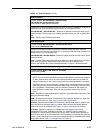
4. Configuration Options
9700-A2-GB20-20 December 2002 4-45
Primary Link RIP
Possible Settings: None, Proprietary, Proprietary In, Standard_out
Default Setting:
–
For multiplexed DLCIs:
Proprietary
–
For nonmultiplexed DLCIs:
Standard_out
Specifies which Routing Information Protocol (RIP) is used to enable routing of
management between FrameSaver units and attached equipment.
Display Conditions
– This option does not appear if Payload Managed is enabled.
None – Does not use a routing protocol.
Proprietary – Uses a proprietary variant of RIP Version1 to communicate routing
information between FrameSaver units. A FrameSaver unit must be on the other end of
the link. This is the factory default for management PVCs configured on multiplexed DLCIs
(see Table 4-11, Circuit Records Options).
Proprietary In – (Release 2.1.) The device distributes only the following local routes to
the far end:
– Trap manager routes
– Default route
– Routes to this device
– MIB-injected routes
– RIP split horizon with poison reversed routes
Standard_out – The device sends standard RIP messages to communicate routing
information only about FrameSaver units in the network. This is the factory default for
management PVCs configured on standard DLCIs.
NOTE: The router must be configured to receive RIP on the FrameSaver management
interface port.
Encapsulation
Possible Settings: Routed
Default Setting: Routed
This read-only field specifies that the IP encapsulation used is RFC 1490/RFC 2427
routed Network Level Protocol IDentifier (NLPID) encapsulation, and not SubNetwork
Access Protocol (SNAP) encapsulation.
Display Conditions
– This option appears only if the PVC is Payload Managed or IP
Enabled.
Routed – IP encapsulation is routed NLPID.
Table 4-19. Management PVC Options (4 of 4)


















